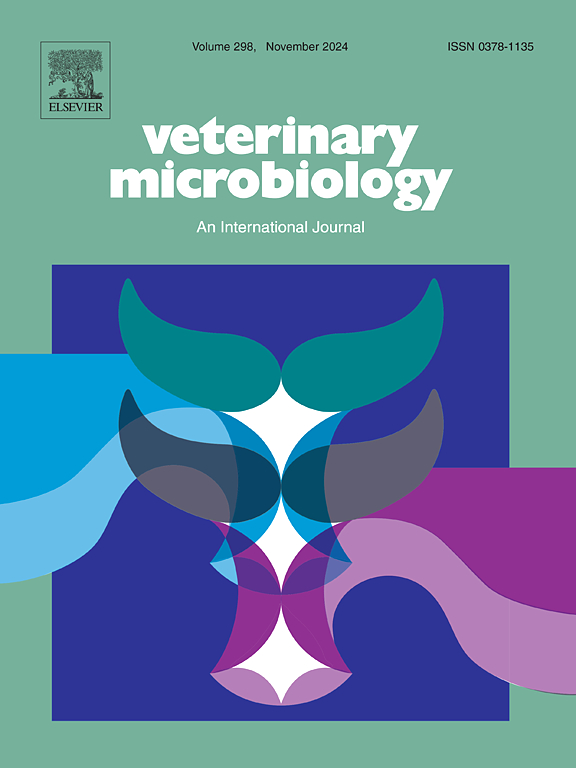Recombinant canine distemper virus expressing virus-like particle VP2 protein of mink enteritis virus protects minks against lethal challenges of both viruses
IF 2.4
2区 农林科学
Q3 MICROBIOLOGY
引用次数: 0
Abstract
Canine distemper virus (CDV) and mink enteritis virus (MEV) are among the most devastating viruses in minks (Mustela vison). They often cause two fatal diseases—canine distemper (CD) and mink viral enteritis (MVE)—resulting in severe respiratory symptoms and acute enteritis in breeding minks, respectively. Here, using the attenuated CDV vaccine strain CDV3-CL (currently employed in breeding mink in China) as a backbone, we constructed a recombinant strain, rCDV3-mVP2, expressing the wild-type MEV capsid protein VP2. Notably, the VP2 protein expressed by this recombinant virus assembles into virus-like particles (VLPs) in Vero cells and exhibits hemagglutination activity. rCDV3-mVP2 exhibits genetic stability through at least 30 serial passages and replicates to titers comparable to the parental CDV3-CL strain in Vero cells. To evaluate its protective efficacy as a bivalent vaccine candidate, twenty weaned minks were immunized with rCDV3-mVP2 (104.0 TCID50) and challenged with a highly virulent CDV strain (SD (14)7; n = 5 minks) or lethal MEV wild-type strain (LN-10; n = 5 minks) 3 weeks post-immunization. A single vaccination with rCDV3-mVP2 induced neutralizing antibodies (mean value = 43) against CDV and hemagglutination-inhibiting antibodies (mean value = 128) against MEV, conferring 100 % protection against lethal challenges of both viruses. Moreover, vaccination effectively alleviated lymphopenia, reduced virus shedding, and minimized tissue viral loads and pathological changes. These results suggest that rCDV-mVP2 is a suitable bivalent live vaccine against CDV and MEV for minks.
Importance
Canine distemper (CD) and mink viral enteritis (MVE), caused by canine distemper virus (CDV) and mink enteritis virus (MEV), respectively, are fatal diseases in minks, with significant impacts on the mink product industry. In this study, we employed reverse genetics to construct a recombinant CDV vaccine strain, rCDV3-mVP2, that expresses stably the MEV VP2 protein. Vaccination of weaned minks with rCDV3-mVP2 safely induced neutralizing antibody responses to both viruses, protecting minks from challenges with lethal CDV and MEV. This is the first study to demonstrate that recombinant CDV can be serve as a bivalent live vaccine for MVE and CD in animals.
表达水貂肠炎病毒病毒样颗粒VP2蛋白的重组犬瘟热病毒可保护水貂免受这两种病毒的致命攻击
犬瘟热病毒(CDV)和水貂肠炎病毒(MEV)是水貂中最具破坏性的病毒(Mustela vision)。它们通常会导致两种致命疾病——犬瘟热和水貂病毒性肠炎——分别导致繁殖水貂出现严重的呼吸道症状和急性肠炎。本研究以中国水貂养殖中使用的CDV减毒疫苗CDV3-CL为骨架,构建了表达MEV野生型衣壳蛋白VP2的重组菌株rCDV3-mVP2。值得注意的是,该重组病毒表达的VP2蛋白在Vero细胞中组装成病毒样颗粒(vlp),并表现出血凝活性。rCDV3-mVP2通过至少30次连续传代表现出遗传稳定性,并在Vero细胞中复制到与亲本cddv3 - cl菌株相当的滴度。为了评估其作为二价候选疫苗的保护效果,用rCDV3-mVP2 (104.0 TCID50)免疫20只断奶水貂,并用高毒力CDV毒株(SD (14)7;n = 5水貂)或致死MEV野生型毒株(LN-10;N = 5只水貂)免疫后3周。单次接种rCDV3-mVP2诱导的CDV中和抗体(平均值= 43)和MEV血凝抑制抗体(平均值= 128),对两种病毒的致命攻击具有100% %的保护作用。此外,疫苗接种有效地缓解淋巴细胞减少,减少病毒脱落,并最大限度地减少组织病毒载量和病理改变。结果表明,rCDV-mVP2是一种适合水貂防治CDV和MEV的二价活疫苗。犬瘟热(CD)和水貂病毒性肠炎(MVE)分别由犬瘟热病毒(CDV)和水貂病毒性肠炎病毒(MEV)引起,是水貂的致命疾病,对水貂制品行业造成重大影响。在本研究中,我们利用反向遗传学技术构建了一株稳定表达MEV VP2蛋白的重组CDV疫苗菌株rCDV3-mVP2。断奶水貂接种rCDV3-mVP2疫苗,可安全诱导对这两种病毒的中和抗体反应,保护水貂免受致命CDV和MEV的攻击。这是首次证明重组CDV可以作为动物MVE和CD的二价活疫苗的研究。
本文章由计算机程序翻译,如有差异,请以英文原文为准。
求助全文
约1分钟内获得全文
求助全文
来源期刊

Veterinary microbiology
农林科学-兽医学
CiteScore
5.90
自引率
6.10%
发文量
221
审稿时长
52 days
期刊介绍:
Veterinary Microbiology is concerned with microbial (bacterial, fungal, viral) diseases of domesticated vertebrate animals (livestock, companion animals, fur-bearing animals, game, poultry, fish) that supply food, other useful products or companionship. In addition, Microbial diseases of wild animals living in captivity, or as members of the feral fauna will also be considered if the infections are of interest because of their interrelation with humans (zoonoses) and/or domestic animals. Studies of antimicrobial resistance are also included, provided that the results represent a substantial advance in knowledge. Authors are strongly encouraged to read - prior to submission - the Editorials (''Scope or cope'' and ''Scope or cope II'') published previously in the journal. The Editors reserve the right to suggest submission to another journal for those papers which they feel would be more appropriate for consideration by that journal.
Original research papers of high quality and novelty on aspects of control, host response, molecular biology, pathogenesis, prevention, and treatment of microbial diseases of animals are published. Papers dealing primarily with immunology, epidemiology, molecular biology and antiviral or microbial agents will only be considered if they demonstrate a clear impact on a disease. Papers focusing solely on diagnostic techniques (such as another PCR protocol or ELISA) will not be published - focus should be on a microorganism and not on a particular technique. Papers only reporting microbial sequences, transcriptomics data, or proteomics data will not be considered unless the results represent a substantial advance in knowledge.
Drug trial papers will be considered if they have general application or significance. Papers on the identification of microorganisms will also be considered, but detailed taxonomic studies do not fall within the scope of the journal. Case reports will not be published, unless they have general application or contain novel aspects. Papers of geographically limited interest, which repeat what had been established elsewhere will not be considered. The readership of the journal is global.
 求助内容:
求助内容: 应助结果提醒方式:
应助结果提醒方式:


